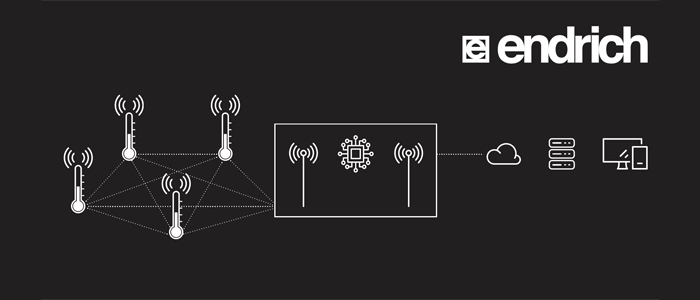
Better smart sensor solutions with ad hoc networks
The E-IOT Platform
A major challenge for industry today is to digitise conventional processes, augmenting machines with low-power, feature-rich microcontroller-based electronics to collect sensor readings and forward data to a cloud database. In this way, it is possible to transform conventional equipment into networked (SMART) devices that report their operating and environmental parameters to a cloud database to support operational safety. Smart functions support predictive maintenance, optimisation of energy consumption and remote monitoring. The E-IOT ecosystem helps to enter this industry by providing hardware and service solutions to transform conventional devices into smart ones. A large number of sensor readings need to be organised in a central database for future processing to meet Industry 4.0 expectations. Our team has developed several hardware elements that use different sensors and mobile technology (M2M/Narrow-Band IoT) to deliver sensor readings to the cloud. At the beginning of the processing chain are sensors that detect and measure various physical parameters, which are processed until they are stored in a cloud database and the data is visually displayed at the end. In between is a sophisticated gateway that collects the sensor readings, pre-processes this data and sends it via a communication channel to a cloud-based database service, where it can be displayed after processing or used for whatever purpose is appropriate for a given task.
But what if the power-saving network used, with its direct sensor-to-cloud concept, does not offer the right solution? What if the battery life is not sufficient due to the frequency of data sending required for the application?
The E-IOT platform in combination with a low-power local ad hoc network.
In this case, we need the help of a low-power local ad hoc sensor mesh network solution, such as NeoCortec offers with its Neo.Mesh. A large number of smart sensors can then be integrated into a local network with extremely low power consumption, where a data concentration gateway ensures that the data is transmitted to the cloud DB via a cellular network such as LTE-M or NB-IoT. Our engineering team has developed a modular sensor network infrastructure that provides either direct sensor-to-cloud communication, point-to-point communication, or a low-power local sensor mesh network and multi-point-to-point communication to the cloud using an LPLAN-to-LPWAN gateway. With the help of the complete E-IoT ecosystem, which consists of the aforementioned smart sensor networks, cloud database and visualisation and data processing system, our company can provide a good solution to connect traditional devices. "SMART" devices to allow for predictive maintenance.
At its core, this solution with Neo.Mesh, the Wireless Mesh Networking Protocol, represents a paradigm shift from conventional network architectures. In contrast to the conventional solution with a central network manager that controls the communication between the nodes, this protocol uses autonomous intelligent nodes as a backbone. As a result, each node is able to act as an independent entity and enable direct communication between nodes without the need for a central entity. The result is a unified network that simply works, no matter how large or complex it becomes. As more nodes join the network, they seamlessly connect to the existing nodes, forming a cohesive communication network that can span large distances. This adaptability and scalability are particularly valuable as an extension of the E-IoT platform when deployed in an area to be covered by hundreds or thousands of sensors. One of the most impressive features of the protocol is its patented routing mechanism. This mechanism ensures that data is routed seamlessly through the network, even if there are obstacles on the RF (radio frequency) path or movement of nodes within the network. Traditional networks often suffer from performance problems when nodes are blocked or dynamically change their position. The Neo.Mesh Networking protocol, on the other hand, eliminates such problems and guarantees reliable data transmission at all times. In practice, this means that the performance of the network is unaffected by environmental factors or dynamic changes within the network itself. Regardless of whether nodes are added, removed or repositioned, the network remains robust and fully functional, ensuring uninterrupted connectivity for all devices and users. Remarkable is the protocol's ability to address vulnerabilities in real networks. By simply adding another node and assigning the appropriate network ID, it seamlessly integrates into the existing network, strengthening its coverage and performance. At the heart of the Neo. Mesh technology is a robust protocol stack with built-in security and reliability features. An important aspect of this security measure is the encryption of all wireless communication between nodes with AES128. This encryption keeps the payload and network communications inaccessible to monitoring by an untrusted entity.
The system is designed for sustained performance. Power consumption is exceptionally low, so batteries last for several years. The Neo-Mesh network follows a time-synchronised protocol where each node spends most of its time in a dormant state. This architectural approach ensures a highly predictable energy consumption pattern for each node in the network. As a result, all nodes consume almost the same amount of energy, allowing each network node to operate efficiently for many years.
The E-IoT, with its Neo-Mesh local sensor network extension, uses sub-gigaherz frequencies to overcome the problems of other protocols in harsh industrial environments. Comparing sub-GHz networking to Wi-Fi and Bluetooth, using the same antennas and transmitting power, it is clear that sub-GHz networking offers greater range. The reason for this greater range is that the lower radio frequencies are not as easily absorbed by physical matter as the 2.4 GHz signals used in Wi-Fi and Bluetooth.
These capabilities of the Neo. Mesh protocol make it an ideal solution for smart sensors installed in large industrial complexes such as factories, buildings, real estate and shops.
More information is available at https://e-iot.info/. E-mail hungary@endrich.com.
